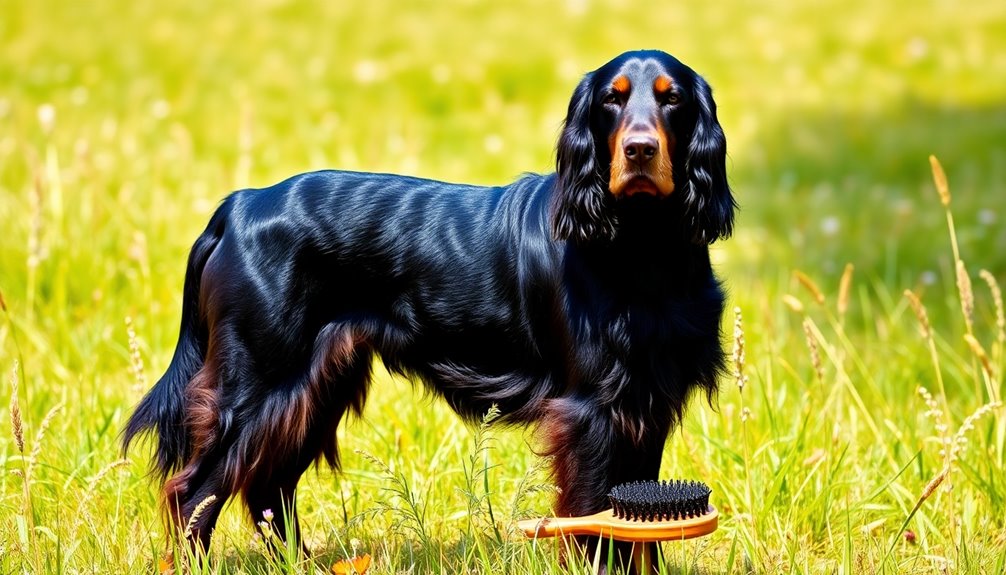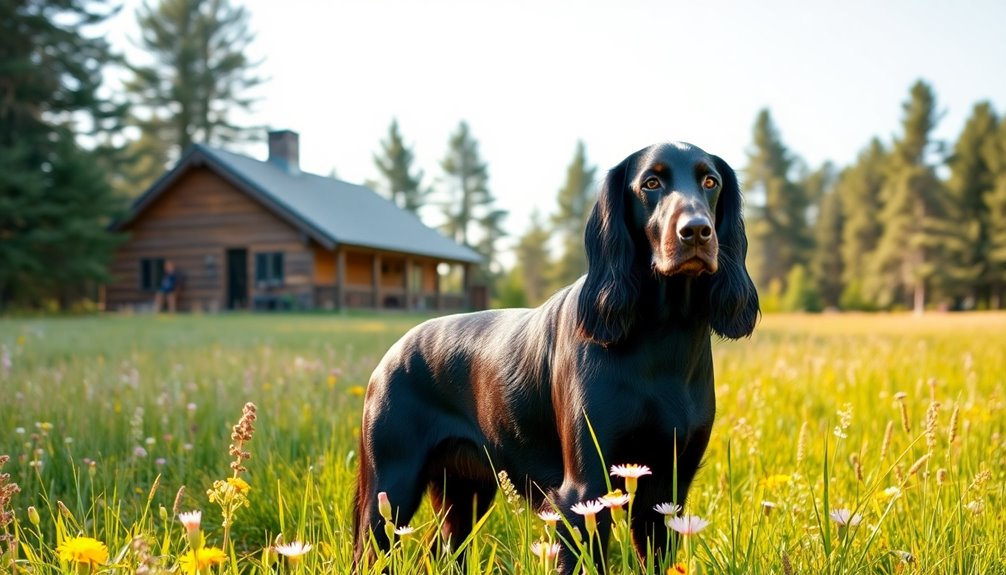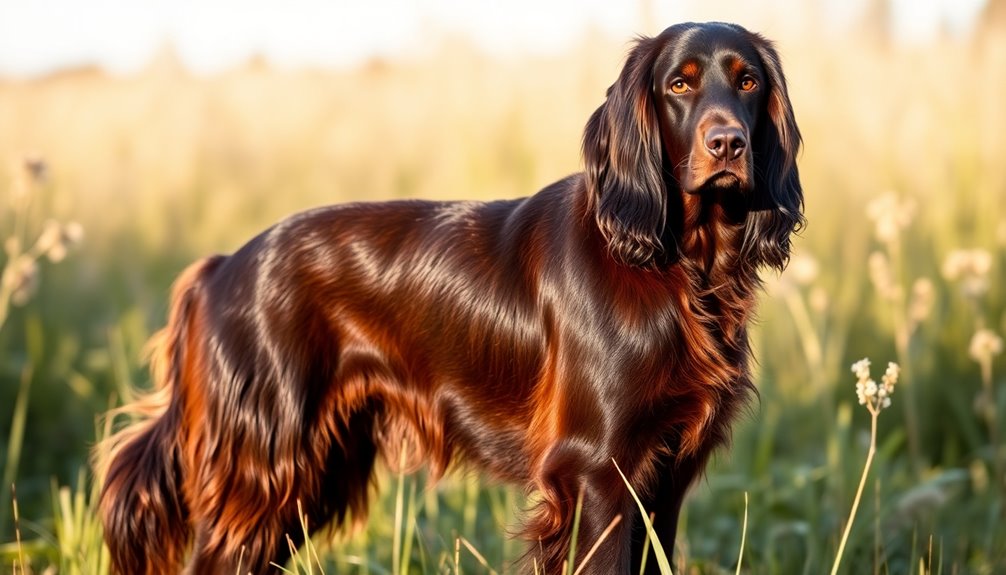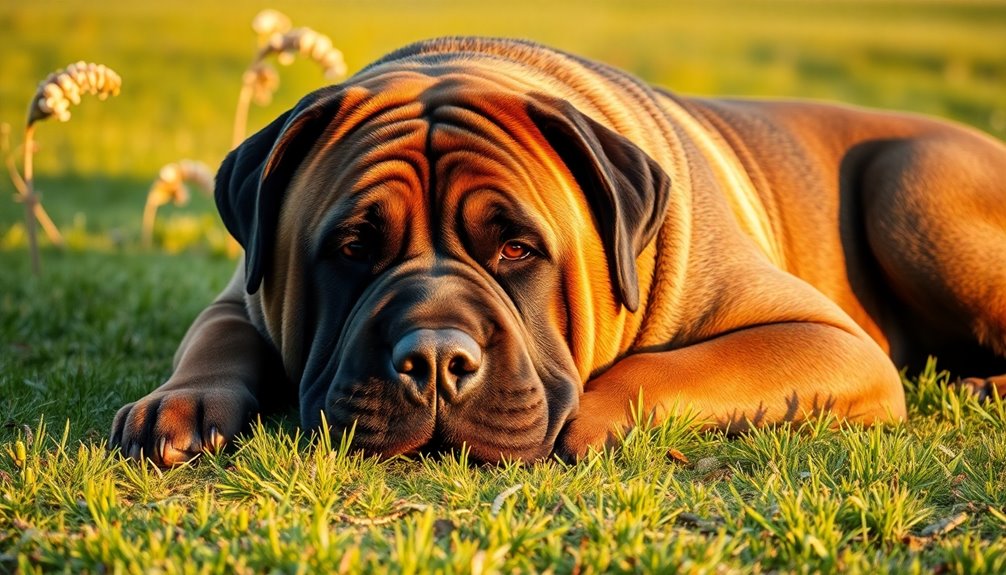The Gordon Setter is a stylish and reliable bird dog, perfect for active families. Standing 23 to 27 inches tall, these dogs boast a striking black and tan coat that demands regular grooming. They're known for their playful temperament and require at least two hours of vigorous exercise daily, making them a fantastic companion for those who enjoy outdoor adventures. While they need consistent training and socialization to curb stubbornness, their affectionate nature makes them a beloved family member. If you're curious about their unique history and health needs, you're in for some fascinating insights ahead!
Key Takeaways
- The Gordon Setter is known for its striking black and tan coat, making it a stylish choice among bird dogs.
- Originating in the Scottish Highlands, the breed was developed for bird retrieving and pointing, showcasing its hunting reliability.
- With a playful and affectionate temperament, Gordon Setters thrive in active households and require ample exercise and socialization.
- Their muscular build and high energy levels make them excellent companions for outdoor activities, requiring at least two hours of daily exercise.
- Regular grooming and a balanced diet are essential for maintaining their health and enhancing their longevity as reliable hunting partners.
Introduction

The Gordon Setter is a strikingly elegant bird dog that captures attention with its tall stature and powerful build. Standing between 23 to 27 inches and weighing between 44 to 83 pounds, this breed showcases a sturdy, athletic frame that exudes grace.
Its coat, which is glossy black and tan, features long, silky hair that's straight or slightly wavy. You'll notice the breed's distinctive tan markings vary from rich chestnut to deep mahogany, with rare red Gordons appearing due to a recessive gene.
Active, alert, and intelligent, Gordon Setters have a playful spirit that lasts well into adulthood, often maintaining a puppy-like demeanor until they're around four years old. They're affectionate and loyal companions but can also be a bit bossy, requiring consistent yet gentle training. Early training is particularly important for this breed, as it helps improve their sociability and adaptability.
Early socialization is crucial for helping them interact well with strangers and other pets.
To keep your Gordon Setter happy and healthy, you'll need to dedicate at least two hours daily to exercise and grooming. Regular ear cleaning and weekly pedicures are essential to prevent health issues, ensuring your stylish bird dog remains vibrant and full of life.
History and Origin

The Gordon Setter originated in the rugged landscapes of Scotland in the 17th century, first noted in Gervaise Markham's 1655 work. You'll find that these dogs were developed not just for their striking appearance but also for their exceptional bird retrieving and pointing abilities. Their history is closely tied to the Duke of Gordon, who significantly shaped the breed's working traits during the 1800s. The breed's development was influenced by the introduction of Bloodhound to enhance their scenting abilities.
Where and when the breed originated
Originating in the rugged Scottish Highlands, Gordon Setters were bred on the estates of the Duke of Gordon, particularly at Gordon Castle near Fochabers. This breed's roots trace back to the 16th or 17th century, with early ancestors appearing in Scotland and England.
The Fourth Duke of Gordon, Alexander Gordon, played a pivotal role in the early 19th century, refining the breed over several generations to enhance its strength and stamina, essential traits for navigating the challenging Highland terrain. Intelligence and keen nose for game were also significant qualities that breeders prioritized during this refinement process.
Breeding took place primarily around the River Spey and the coast of Moray, showcasing the breed's connection to Scottish society and nobility. By the 1820s, the present-day Gordon Setter began to emerge.
The Duke's kennels at Gordon Castle became famous for producing these elegant dogs. The breed didn't just remain in Scotland; it made its way to the United States in 1842, thanks to Daniel Webster and George Blunt.
The Gordon Setter's journey from the Scottish Highlands to the rest of the world underscores its enduring legacy and appeal, making it a beloved choice for both hunting and companionship.
Bird Retrieving and Pointing
As Gordon Setters evolved, their primary role in bird hunting became well-defined, showcasing their exceptional abilities as both pointers and potential retrievers. Originally bred to locate upland game birds like partridge and pheasant, these dogs initially indicated the presence of birds by "setting," crouching low for hunters to cast nets.
With the advent of firearms, their role shifted to pointing and holding the point, allowing hunters to take a shot.
Over time, Gordon Setters specialized in pointing, while breeds like Labradors took on retrieving tasks. Their natural pointing instinct, honed through generations, makes training them straightforward. You might use hard flying pigeons and check cords to help your Setter learn to point reliably, focusing on no-stress methods that allow them to develop naturally. Interestingly, current trends suggest that British setters lack a genuine retrieving instinct, which contrasts with the increasing interest in training Gordon Setters for retrieving tasks.
While their retrieving instinct has been historically suppressed, some Setters display a knack for retrieving dead or wounded birds. Increasingly, handlers are training them for both roles, reflecting a trend towards all-round shooting companions.
As you continue to explore the
Physical Characteristics

When you look at a Gordon Setter, you can't help but notice their impressive size and weight, with males standing 23 to 27 inches tall and females a bit shorter. Their medium-length, silky double coat features beautiful feathering on their legs and tail, adding to their elegance. This striking combination of size and coat makes the Gordon Setter a standout in the bird dog world. Historically, the breed was developed through selective breeding efforts by the Duke of Gordon to create the distinctive black-and-tan coat we see today.
Size, weight, and coat details
The Gordon Setter boasts impressive physical characteristics that make it a striking presence in the field. Males typically stand between 24 to 27 inches tall, while females measure 23 to 26 inches.
You'll notice that males are generally taller and heavier, weighing between 55 to 80 pounds, compared to females who range from 45 to 70 pounds. This size contributes to the breed's muscular build, which is essential for their hunting capabilities.
In terms of coat, the Gordon Setter showcases a predominantly black double coat adorned with rich tan markings. You can spot these tan accents on the muzzle, throat, lower legs, eyebrows, and rear, with clear, defined lines separating the black and tan areas. Additionally, the breed is recognized for its distinctive black and tan coat, which enhances its appeal.
It's important that there are no tan hairs within the black areas, especially around the eyes. The ideal tan color resembles rich chestnut or mahogany red.
The coat itself is medium-length, soft, and shiny, resembling silk. It can be straight or slightly waved, though it shouldn't be curly.
You'll appreciate the long hair on the ears, under the stomach, and on the chest, making this breed not only stylish but also well-equipped for outdoor activities.
Feathered Legs and Tail
Feathered legs and a plumed tail are defining features of the Gordon Setter, enhancing both its functionality and aesthetic appeal. The feathering on the legs, found on both front and back, gives this breed a distinctive look but can tangle easily, requiring regular grooming.
You'll want to trim the hair on the inside of the legs to keep it neat and prevent it from hanging out, ensuring it balances well with the rest of the coat. Regular trimming prevents see-through areas that detract from the coat's appearance, maintaining a polished look.
The tail is another crowning glory, long, straight, and beautifully plumed. When trimming the tail's feathering, aim for a length that complements the overall coat. Be careful not to cut it too short; harmony with the rest of the grooming is key.
Properly maintained feathering not only looks stylish but also protects the dog from rough terrain and weather, a nod to its hunting origins. Use scissors to shape the feathered areas, keeping a 90-degree angle for evenness. Regular grooming is essential to avoid matting and tangling, ensuring your Gordon Setter maintains its dignified bearing and overall health.
Temperament and Personality

Gordon Setters are playful and intelligent, making them a joy to have around. They're well-suited for families and individuals alike, easily bonding with other pets in the household. Their affectionate nature and high energy mean they'll thrive in an active environment where they can engage and learn. These dogs require approximately one hour of exercise daily to keep them physically and mentally stimulated.
Playful and Intelligent Nature
Exuding playful energy, Gordon Setters thrive on physical activity and mental stimulation. These dogs are highly energetic and need plenty of daily exercise to stay happy and healthy. An enclosed yard is essential for them to safely burn off energy, especially since they can be quite boisterous during their puppy and young adult stages.
Their powerful hunting instinct makes them love activities like running and chasing, so incorporating playtime into their routine is crucial to prevent rowdiness. Additionally, their sturdy and stylish appearance contributes to their appeal as a versatile family companion and hunting partner.
In addition to their playful nature, Gordon Setters are highly intelligent and eager to learn. They respond well to positive training methods, allowing them to excel in various pursuits, including hunting and agility. However, they can be stubborn at times and prefer to think for themselves, so patience and consistency in training are key.
These affectionate and loyal companions thrive in a loving environment, and their protective instincts make them good watchdogs. Just remember, socialization and early obedience training are vital to ensure they grow up friendly and well-adjusted.
With the right approach, you'll enjoy a wonderfully playful and intelligent companion in your Gordon Setter.
Suitability for families, individuals, or other pets
When considering a Gordon Setter for your home, you'll find they're exceptionally suited for families and individuals who lead active lifestyles. Their affectionate and loyal nature makes them fantastic family pets, especially for those with older children. These dogs require plenty of exercise and mental stimulation, so they thrive in dynamic households. However, if you're away for long periods, be mindful of their tendency toward separation anxiety, which can lead to destructive behaviors.
For individuals, a Gordon Setter fits best if you maintain an active lifestyle. They need consistent training and socialization to curb their stubborn streak. Additionally, a yard is essential for them to run and play; apartment living isn't ideal. Given their high energy, they require 1-2 hours of daily exercise and mental engagement to keep them happy and healthy.
Regarding other pets, their high prey drive means they aren't the best match for homes with small animals like cats. While they can coexist with other dogs, early socialization is crucial to prevent wariness. With proper training and supervision, they can be tolerant of other pets but may still chase smaller animals due to their instincts. Overall, the Gordon Setter can be a loyal companion, as long as you meet their needs.
Health and Lifespan

When it comes to the health and lifespan of your Gordon Setter, understanding their typical lifespan of 10 to 15 years is crucial. You should also be aware of common health concerns like eye problems and heart conditions that can affect them. Regular health assessments are critical for early detection of health issues that may arise throughout their life.
Typical lifespan of the breed
Gordon Setters often live a fulfilling life span of 12 to 13 years, with a life expectancy that can range from 10 to 15 years. A 2024 UK study revealed an average life expectancy of 12.4 years for this breed. When you bring a Gordon Setter into your home, you should plan for over a decade of companionship.
Several factors can influence their lifespan. Maintaining regular veterinary check-ups is crucial to catch any potential health issues early. A balanced diet tailored to your dog's age and consistent exercise are essential components of their care. Additionally, being aware of common health issues is vital for proactive management of your dog's wellbeing.
You'll find that preventive health measures, like regular grooming and dental care, can significantly extend their life.
Moreover, creating a safe and stimulating environment helps keep your Gordon Setter happy and healthy. This includes providing mental stimulation and supervised activities in a fenced yard.
Common health concerns or genetic predispositions
Common health concerns and genetic predispositions can significantly impact a Gordon Setter's life, so it's crucial for owners to be aware of these issues.
One major concern is cerebellar degeneration, a progressive neurological disorder that manifests between 6 months and 4 years of age. Symptoms include an ataxic gait and intention tremors, leading to severe coordination loss. Regular vet check-ups can help monitor for early signs of this condition.
Gastric dilatation-volvulus (GDV) is another life-threatening condition, particularly common in deep-chested breeds like Gordon Setters. Signs include a swollen abdomen and restlessness, requiring immediate veterinary attention to prevent high mortality risk.
You should also be mindful of hypothyroidism, which can cause dry skin, weight gain, and behavioral changes. Blood tests can diagnose this condition, and hormone replacement therapy is a common treatment.
Additionally, Gordon Setters are prone to hemangiosarcoma, a bleeding tumor often detected late, and progressive retinal atrophy, which leads to vision loss.
Kidney disease, specifically glomerulonephropathy, is another inherited risk, making yearly urine analysis essential.
Regular dental care is vital too, as dental disease is prevalent in the breed, impacting overall health.
Tips for maintaining health and wellness
To ensure your Gordon Setter enjoys a long and healthy life, it's important to focus on diet, exercise, grooming, and general care.
Start with a high-quality diet rich in protein from sources like beef, chicken, or fish. Incorporate essential fatty acids and a few carbohydrates from vegetables and berries for added nutrients. Don't forget to provide plenty of fresh water to keep your dog hydrated.
Daily exercise is crucial. Aim for at least an hour of physical activity, such as running or playing fetch, to match their high energy levels. Mental stimulation is equally important, so consider puzzle toys or training sessions to keep them engaged. Regular exercise helps maintain a healthy weight and prevents behavioral issues(high energy levels).
Grooming requires daily brushing to prevent mats and control shedding. Regularly clean their ears and trim their nails to prevent discomfort. Brush their teeth at least twice a week for good dental health.
Consistent veterinary check-ups are vital to monitor your dog's health. Keep their routine steady and supervise them like a toddler to avoid accidents.
Lastly, consider safe dental chews to promote oral hygiene while ensuring they're under your watchful eye. Following these tips will help your Gordon Setter thrive.
Care Requirements

Caring for your Gordon Setter means staying on top of their grooming, exercise, and diet.
You'll need to brush their coat regularly to prevent matting, while also ensuring they get plenty of daily exercise to match their energy levels. High energy levels require regular exercise to avoid boredom, making it essential to engage them in various activities. Additionally, feeding them a high-quality diet tailored to their needs is crucial for their overall health and well-being.
Regular Brushing Required
Regular brushing is crucial for maintaining the Gordon Setter's stunning coat and preventing matting. You should brush your dog at least once a week to keep the coat soft and shining. This routine helps distribute natural oils throughout the fur, promoting a healthy look while allowing you to spot any skin issues or dandruff early on. Start brushing your Gordon Setter as a puppy to get them accustomed to the process.
Focus on areas prone to matting, such as the ears, under the stomach, and on the chest. Don't neglect the long hair on the back of their fore and hind legs, as well as the tail and featherings, which can tangle easily. Use an undercoat rake to minimize skin damage, and employ a slicker brush or pin brush for general maintenance. The grooming process emphasizes natural flow and softness in appearance, which is essential for the breed's aesthetic.
Thinning shears are great for trimming excess hair around the feet and ears, while straight shears work well for tail featherings. Additionally, clip the long extensions of hair near the feet and ears regularly, and keep up with nail trimming.
Clean your dog's ears weekly and brush their teeth at least twice a week to maintain overall health.
Exercise requirements and energy levels
Gordon Setters thrive on a daily exercise regimen of 1.5 to 2 hours, making them a perfect match for active families. These high-energy dogs need vigorous workouts, which can include brisk walks, jogging, and off-leash playtime. You'll find that they enjoy activities like fetch and agility training, so mixing it up keeps things interesting for both of you. As puppies, they require gentle exercise, gradually increasing to full adult levels by around 12 to 18 months. It's important to tailor their routine to their individual needs and health status. Gordon Setters have incredible endurance, favoring longer runs and hikes, so access to trails or open spaces is essential. Additionally, because they are highly intelligent, they excel in dog sports and training exercises that challenge their minds. Mental stimulation is just as important as physical activity. Engage their intelligent minds with dog sports, training exercises, and puzzle toys. Early socialization is vital, exposing them to various environments and people.
Feeding tips and diet recommendations
A well-balanced diet is key to keeping your Gordon Setter healthy and energetic. Focus on high-quality protein sources like beef, chicken, and fish. These provide essential fatty acids, which are vital for energy and overall health. A raw diet can lead to better digestion and reduced flatulence, enhancing your dog's overall comfort.
Incorporate small amounts of carbohydrates from vegetables, herbs, and berries to ensure adequate fiber and antioxidants.
Consider a raw diet; it can prevent common health issues like obesity and dental problems while improving gut health. This approach may also reduce vet bills due to fewer health-related visits.
Monitor portion sizes to avoid obesity, adjusting based on your dog's weight and activity level.
Feed multiple smaller meals throughout the day rather than one large meal to prevent bloat, and avoid raised food bowls for the same reason.
After mealtime, restrict exercise for an hour to support digestion.
If needed, consider joint supplements, probiotics, and omega-3 fatty acids to enhance your dog's well-being. Always consult your veterinarian before adding any supplements.
Training and Socialization

When training your Gordon Setter, you'll find they respond moderately well to commands, so staying consistent is key. Establishing a routine for training sessions can help reinforce basic commands and ensure effective learning. Gradual introductions to new friends and environments can help them feel more comfortable and less overwhelmed. Also, be prepared to tackle leash pulling during walks to ensure enjoyable outings together.
Moderately Responsive to Commands
Training a Gordon Setter requires patience and consistency, as they're moderately responsive to commands. You'll find that these dogs respond best to positive reinforcement techniques, such as treats, praise, and play.
Stick to a regular training schedule, as consistency helps them thrive on routine. Use gentle but firm methods to guide them, and make sure your entire family is on the same page with commands.
Start training as soon as your puppy comes home to establish good habits early. Keep training sessions short, focused, and fun to maintain their interest. While they can learn basic commands like sit, down, and stay, be prepared for some stubbornness. If you encounter recall issues, consider using a checkcord until they reliably return.
Avoid harsh corrections, as they can alienate your dog and hinder progress. Instead, focus on positive reinforcement to build a strong bond.
Ensure everyone in your household maintains consistent commands and rules to avoid confusion. Establish clear leadership and set boundaries gently, which will help guide your Gordon Setter toward being a well-behaved companion. Additionally, incorporating early socialization into their training will promote well-rounded behavior and confidence in various situations.
Gradual Introductions to New Friends
To ensure your Gordon Setter develops strong social skills, early socialization is key. Enroll your pup in puppy kindergarten classes to kick off their learning journey.
Invite friends and family over to your home, exposing your dog to various people and fostering positive interactions. Regular visits to busy parks and dog parks will allow them to meet other dogs and individuals, enhancing their adaptability. Exposure to various experiences is crucial for their behavioral development. Engaging with educational toys can also stimulate their mental agility, complementing their socialization efforts.
Use positive reinforcement methods like treats and praise to encourage these interactions. Incorporate playdates with other dogs to sharpen social skills and take part in dog-friendly community events for varied experiences.
Don't shy away from traveling with your dog; new environments can build their confidence. Since Gordon Setters can be reserved, it's crucial to socialize them from an early age to prevent shyness around strangers.
Introduce them to different people, including children, to improve their kid-friendliness. Monitor interactions with unfamiliar dogs, ensuring a safe and positive environment.
Regular mental stimulation will help maintain their adaptability and confidence, making them a well-rounded companion ready to meet new friends.
Leash Pulling During Walks
Leash pulling can be a frustrating challenge for many Gordon Setter owners, but with the right approach, you can transform your walks into enjoyable experiences.
Start by getting your dog used to the collar and leash around the house. Reward them with treats and praise when they're comfortable. Use leash drags to help them adjust without the pressure of immediate walking commands.
Once they're comfortable, begin walking them indoors, rewarding them for staying close. Transition to outdoor walks in low-distraction areas, using a lure stick with treats to maintain their focus. This gradual introduction helps teach the dog the concept of leash resistance effectively.
Remember, hold the leash with minimal resistance; this helps them understand leash dynamics better.
If your dog pulls, stop walking immediately. Wait for the leash to slacken before continuing. Gentle corrections, like pulling up and releasing, can be effective. You can also use "switch backs" by turning 180 degrees when they pull. Call them back to your side and reward them when they comply.
Consistency and patience are key. Establish a routine, practice regularly, and avoid punishment.
With time, your Gordon Setter will learn to walk calmly beside you, making your outings much more enjoyable.
Ideal Living Environment

If you're considering a Gordon Setter, you'll need a spacious home with a large, securely fenced yard.
These energetic dogs thrive in cooler, temperate climates, making a country setting ideal for their exercise and hunting instincts.
Providing them with plenty of room to run freely is essential for their well-being. Additionally, they require at least two hours of vigorous exercise daily to meet their energy needs.
House With a Large Yard
A spacious home with a large, securely fenced yard is essential for a Gordon Setter's happiness and well-being. These dogs are bursting with energy and require ample space to burn it off. A fenced yard not only keeps them safe from wandering but also allows them to engage in vigorous exercise and play without worry.
You'll want to ensure the yard is secure to prevent your Gordon Setter from chasing after birds or other small animals that pique their interest. Daily, they need at least two hours of rigorous exercise, which can include long walks, interactive games, or retrieving toys in water. This consistent activity helps prevent boredom and undesirable behaviors. Additionally, this breed is known for being a sturdy hunting dog, which means they thrive in environments that allow for physical activity and exploration.
Gordon Setters thrive in homes where someone is around most of the time, making them excellent family pets. They're affectionate and loyal, bonding well with kids and other pets when properly socialized.
However, they aren't suited for apartment living due to their energy levels and space requirements. Regular supervision and a safe environment are crucial for their well-being, along with access to fresh water and shade during warm weather.
Prefers Cooler, Temperate Climates
Gordon Setters thrive in cooler, temperate climates, making these environments ideal for their comfort and well-being. Originating from Scotland, they're well-adapted to cold and windy weather, which means they struggle in hot climates. Their thick, double coat and robust build help them withstand lower temperatures, while their exceptional stamina allows them to engage in long outdoor activities without overheating.
In cooler climates, their high energy levels are easier to manage. You'll find that they can cover over 50 miles in a single day, making ample exercise essential for their mental and physical health. Regular outdoor adventures become more enjoyable when the weather's cooler, helping prevent heat stress and allowing their natural instincts to shine. Additionally, their exercise needs require at least 2 hours of activity daily, which is more manageable in cooler weather.
Maintaining their coat is also simpler in temperate conditions, as it requires regular brushing to avoid matting but is less cumbersome when it's not sweltering outside. Cooler temperatures reduce the risk of heat-related health issues, ensuring your Gordon Setter stays happy and healthy.
Unique Coat Color Variations

When you think of Gordon Setters, you likely picture the classic black and tan coat that dominates dog shows. However, rare color variations like red and liver exist, thanks to recessive genes, making them unique but seldom seen in competitive settings. These striking colors have even made appearances in Hollywood, showcasing how diverse this breed can be beyond the standard look. Responsible breeding practices can help manage the inheritance probabilities of these recessive color genes, ensuring a healthy and varied gene pool.
Rarely Seen in Dog Shows
Rarely making appearances in dog shows, unique coat color variations in Gordon Setters often go unnoticed by the general public. The officially recognized black and tan combination features a coal-black coat with rich chestnut or mahogany markings on the paws, lower legs, throat, and muzzle. You might even spot a small amount of white on the chest, but the striking contrast between the black and tan is what truly stands out.
On the other hand, you may come across red Gordon Setters, which arise from a recessive gene. Although about 25% of puppies from two carrier parents can be red, these dogs face disqualification in the show ring. Additionally, the Gordon Setter's high energy level necessitates ample exercise to maintain their health and well-being.
You may also notice liver and tan variations, similar to chocolate, but these colors also remain unrecognized for showing.
Historically, you might find accounts of black, white, and tan combinations from Gordon Castle kennels, but these colors are now extremely rare and not eligible for modern standards.
Despite their unique beauty, these variations often remain in the shadows, showcasing the rich genetic diversity within the Gordon Setter breed.
Hollywood's Canine Co-Star
Stepping into the spotlight, the Gordon Setter hasn't only charmed hunting enthusiasts but also captured the hearts of Hollywood filmmakers. Its striking black and tan coat is a dominant feature, but you might be surprised to learn about the unique color variations lurking beneath the surface.
While the breed standard emphasizes a coal-black coat with rich chestnut markings, recessive genes can introduce some uncommon hues. If you're looking to expand your knowledge, red and liver variations are possible, albeit rare. If both parents carry the recessive red gene, about 25% of their puppies could be red instead of the typical black and tan. Understanding the K locus is crucial for breeders to predict these color outcomes accurately.
Genetic testing is essential for breeders wanting to manage these variations, as it helps determine if a dog carries recessive genes. Though predominantly tan, red, or buff Gordons aren't show-eligible, they still showcase the breed's genetic diversity.
Tricolour variations, while uncommon, can occur too. Remember, these unique coat colors don't impact the Gordon Setter's temperament or hunting prowess; they merely add a dash of flair to an already stylish and reliable bird dog.
Active Lifestyle Compatibility?

If you lead an active lifestyle, a Gordon Setter might be the perfect addition to your family. These dogs thrive on exercise and enjoy participating in activities like hiking, jogging, and playing fetch, making them ideal for energetic households. Just be prepared for regular grooming sessions to keep their stylish coat in top shape! Their moderate to high energy levels ensure they are always ready for the next adventure.
Ideal for Active Families
Since Gordon Setters thrive on activity, they're a perfect match for active families looking for a dynamic companion. These dogs require at least two hours of exercise each day, which can include brisk walks, jogging, cycling, and hiking. They love off-leash playtime in secure areas, making it essential to provide them with physical and mental stimulation.
Engaging in activities like fetch, agility training, or even field trials will keep them happy and healthy. Additionally, their high energy levels make it important to ensure they have continuous outlets for exercise to prevent boredom.
Training is equally crucial, as Gordon Setters respond well to positive reinforcement. Starting obedience training and basic commands at a young age helps them develop into well-behaved family members. They enjoy mental challenges, so incorporating puzzle toys or scent work can keep their minds sharp.
Known for their gentle and affectionate nature, Gordon Setters bond well with children. Their patient demeanor and protective instincts make them reliable companions in a family setting.
Just remember, they need interaction and attention to prevent separation anxiety. With a secure yard and enough space for daily activities, you'll find that a Gordon Setter enriches your active lifestyle and brings joy to your family.
Grooming Needs and Time Commitment
While Gordon Setters are energetic companions for active families, their grooming needs require a significant time commitment. To keep their long, silky coat in top shape, you'll need to brush them daily to prevent matting and control shedding.
Use a variety of brushes, including a large square head, oval brush head, and round brush head, along with a gentle comb and detangling lotion whenever necessary. Regular brushing is essential to maintain coat health and reduce the risk of matting.
Occasional full washes with a specific dog shampoo and conditioner are important, but don't overdo it—frequent bathing can strip their coat of natural oils. You'll also want to schedule professional grooming sessions to maintain their feathers and trim around their paws.
In addition to coat care, regular ear cleaning is essential to prevent infections, and weekly nail clipping keeps their feet comfortable.
After wet walks, towel drying with quality microfibre towels helps keep your dog dry and warm.
Frequently Asked Questions
How Much Exercise Does a Gordon Setter Need Daily?
A Gordon Setter needs about 1-2 hours of exercise daily to stay healthy and happy.
You should include brisk walks, jogging, and off-leash playtime in secure areas. Engage them in activities like fetch or agility training to keep their energy levels in check.
Don't forget that mental stimulation through puzzle toys is just as crucial.
Always provide fresh water and shade during warm weather to prevent overheating after vigorous play.
Are Gordon Setters Good With Children and Other Pets?
If you're considering a Gordon Setter, know that they can be moderately good with children, especially older ones.
They're energetic, so they might overwhelm toddlers.
With proper training and socialization, they can also get along with other dogs and even cats, provided they've been raised together.
Just keep an eye on them around smaller pets, as their hunting instincts may kick in.
Early exposure helps create a well-adjusted companion for your family.
What Is the Average Cost of a Gordon Setter Puppy?
The average cost of a Gordon Setter puppy typically ranges from $1,000 to $2,000.
This price can vary depending on the breeder, bloodline, and location. You'll likely find that this cost includes health and temperament screenings, initial vaccinations, and possibly pedigree papers.
If you're considering other options, adoption from local shelters or breed-specific rescues can be more affordable and give a loving home to a dog in need.
Do Gordon Setters Have Any Common Behavioral Issues?
Yes, Gordon Setters can have common behavioral issues. They often display stubbornness and may struggle with training consistency.
If you don't provide enough exercise and socialization, they might develop anxiety, excessive barking, or destructive behavior.
They can be easily distracted, making training challenging, and may jump up or refuse to walk calmly on a leash.
Regular interaction and a structured routine are essential to help manage these behaviors effectively.
Can Gordon Setters Adapt to Apartment Living?
Gordon Setters can't adapt well to apartment living. They need a house with a secure yard to run and play freely every day.
Their large size and high energy levels make confined spaces challenging. Without enough room to exercise, they may develop behavioral issues like barking or chewing.
If you're considering getting a Gordon Setter, ensure you have ample outdoor space and can commit to their daily exercise requirements for their well-being.
Conclusion
In conclusion, the Gordon Setter is not just a stylish bird dog; it's a loyal companion that thrives in an active lifestyle. With its rich history and unique coat variations, this breed offers both beauty and reliability. By providing proper training, socialization, and a suitable living environment, you'll ensure your Gordon Setter becomes a well-adjusted member of your family. If you're ready for an adventure buddy, this breed might just be the perfect fit for you!










